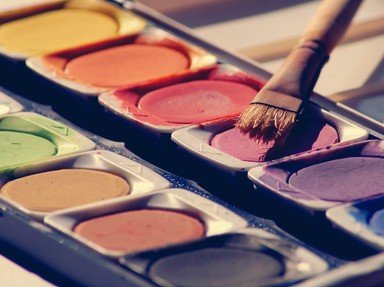Quiz Answer Key and Fun Facts
1. You might take up painting as a hobby. One of the first decisions you'll need to make is what type of paints you want to use. Which of the following paints does *NOT* clean up using water?
2. I don't know if you've ever looked in a craft store, but there are usually paint brushes galore. Which of these is *NOT* a part of a paintbrush?
3. If you decide to paint on canvas, many can be purchased primed for oil or acrylic paints. Which of these primers is made from paint pigment, chalk and a binder?
4. In order to provide stability and keep the canvas at the correct height, which of the supplies below will the painter need?
5. Which of these painter's supplies can be used to show a painter how to mix various paints to achieve new colors?
6. One of the supplies a painter needs is a surface on which to mix the paints. Which of these traditional supplies can be used?
7. A painter must decide what they are going to paint. Many beginners start with trying to depict inanimate objects such as fruit or bottles. What is this type of painting called?
8. Do painters need to know how to draw?
9. All painters should think about the placement of the objects or figures on the canvas. What word would be used to describe this?
10. Once a painting is completed you may want to save it (or you may want to paint right over it!). If you decide to save it, how can you easily finish the edges so that the overlapping paint is no longer visible?
Source: Author
mlcmlc
This quiz was reviewed by FunTrivia editor
looney_tunes before going online.
Any errors found in FunTrivia content are routinely corrected through our feedback system.
